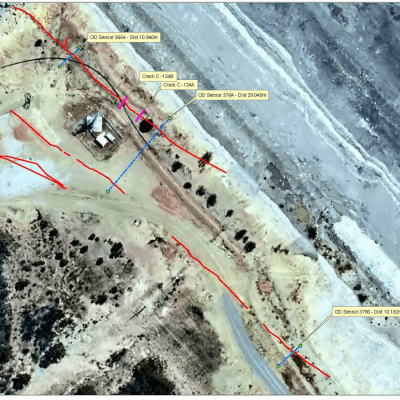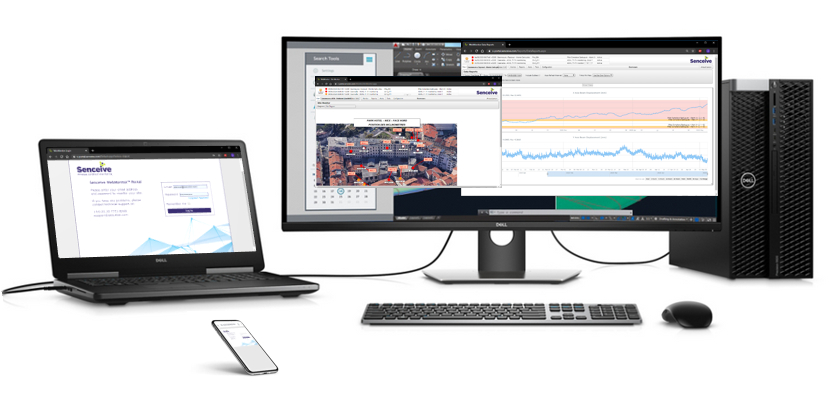These automated systems are more efficient, accurate, and thorough than labour-intensive traditional systems that rely on more manual processes and are harder to scale.
Automated mine monitoring technology picks up deformations in mine structures by tracking movement, temperature, vibration and more. The data is sent wirelessly to the office for review by managers, surveyors and other key stakeholders, where they can analyse changes over time or get immediate alerts if there are more significant movements that require prompt attention.
These systems are becoming increasingly popular following dam collapses at a Brazilian mine in 2015 and 2019, which were reportedly preventable if structural issues raised in earlier dam reports were heeded.
Out with the old, in with the new
Traditional methods of monitoring high-risk mining infrastructure required monthly on-site mine surveyors taking manual measurements of each critical monitoring point. Aside from the issue of human error, manual surveyor inspections were labour intensive, inefficient, and generally only occurred once a month. Damage can occur and impact the site in a day.
New automated mine monitoring methods include the installation of nodes placed across the mine site in key locations. With these in place, technicians can receive data from them directly to their computer at configured time periods, for example every 10, 30 or 60 minutes. The time saved manually inspecting and monitoring assets can now be used to focus on reading and interpreting the data to the greatest effect. And with more data available over a given timeframe, engineers, surveyors and managers can identify subtle changes early to proactively manage assets.

Monitoring dam walls and geotechnical structures
Automated mine monitoring technology was originally designed for monitoring structures, including dam walls, mine walls, and roads.
Measuring movement on these kinds of structures manually is the most labour-intensive part of the traditional mine monitoring process. Where fixed plant structures might only have a few data points to collect, an open pit might have hundreds. Rather than spend hours walking around these, autonomous mine monitoring systems can collect these data points simultaneously and at more regular intervals.
Mine monitoring systems that allow technicians to focus on finding inconsistencies in data rather than on collecting it are vital when monitoring dam walls and geotechnical structures. The data that mine monitoring systems provides can be used to indicate potential rockslides, cracks, or anything else that would cause a dam wall or geotechnical structure to fail. These structures fail the fastest on site, making them more likely to cause disaster if early signals are not identified and acted upon. With data coming through at frequent intervals, however, technicians can get on top of it fast – ordering the preventative maintenance prior to damage, loss of work, and safety issues.


Monitoring fixed plant
Fixed plant, including crushers, screeners, and conveyors, are also prone to structural damage often found in dam walls, mine walls, and more.
Conveniently, the same instrumentation used on tailings dams and within the mine itself, has the capacity to work on fixed plant in the same way.
Fixed plant is integral infrastructure on a mine, completing the bulk of the vital crushing, screening, and material processing work. These pieces of equipment are often purpose-built for a mine, which means they’re built to last only the extent of the initially-proposed mine life.
When more resources are found and the mine life is extended, this plant becomes more likely to suffer maintenance issues and require repairs, so should be monitored closely.
Automated monitoring systems can pick up issues and transfer that data at regular intervals. This ability is essential for monitoring fixed plant. If the plant breaks down, the entire mine can come to a standstill, and it is well understood that they’re much less replaceable than earthmoving machinery. Using automated mine monitoring technology can ensure issues are solved as soon as they arise, and the mine can keep running.
Aptella’ mine monitoring systems stop disasters before they happen
Australian mining companies have always prioritised the safety of their workers and the integrity of mine structures. However, after the Brazil mine disaster in 2019, the mining industry is becoming even more vigilant about disaster prevention. Aptella provides automated mine monitoring systems that can help with that. Learn more about them here, or contact us for an obligation-free quote.

Kami membangun bisnis dengan memberikan solusi teknologi konstruksi untuk meningkatkan produktivitas pelanggan kami.
PT Aptella Solusi Teknologi
NPWP: 70.620.776.8.017.000
2024 Aptella | NPWP: 70.620.776.8.017.000 | Terms and Conditions | Privacy Policy